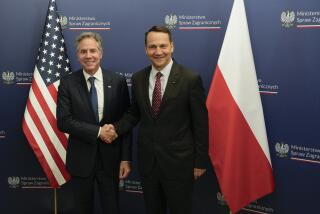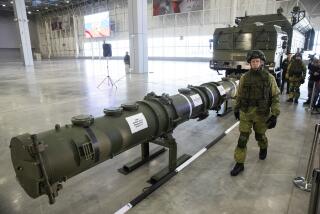U.S. Rejects New Soviet Proposal : Kremlin Adds Potential New Talks Obstacle
GENEVA â In a proposed treaty to eliminate medium-range weapons from Europe, the Soviet Union on Tuesday made public sweeping provisions for verification and inspection of dismantled missiles but also introduced a potential new obstacle on the issue of shorter-range missiles.
Soviet negotiator Alexei A. Obukhov revealed at a news conference the details of his countryâs proposals--presented Monday to the American delegation to the arms talks here--which would ultimately eliminate both medium-range and shorter-range nuclear missiles from Europe.
Obukhov, however, said that nuclear warheads on West German Pershing 1A shorter-range missiles âmust goâ if there is a U.S.-Soviet accord on eliminating shorter-range missiles from Europe.
U.S. Controls Warheads
West Germany has 72 older Pershing 1A missiles, but they are under joint U.S.-German control and until now have been excluded from the superpower talks on arms limitation. The United States controls the missilesâ warheads, and the West Germans control the missiles themselves.
On the thorny issue of how each side can confirm that the other has adhered to the elements of any arms agreement, Obukhov said, âWe stand for the most rigorous verification, for verification and inspection everywhere.â
In the past, American negotiators at the talks have feared that verification of missile reductions and on-site inspection might be the greatest block to any accord between Washington and Moscow.
But this was the first time that the Soviet negotiators offered--in their draft of an arms treaty--what Obukhov called a âradical solution in the elimination or reductionâ of weapons.
The Kremlin negotiator, who is deputy leader of the Soviet delegation here, declared that the Soviets would agreed to inspection:
âOn the sites of missilesâ dismantling, on the sites of their elimination, at ranges and military bases, including third countries, at depots and factories. These ideas are embodied in relevant provisions of our draft.â
âArmies of Commasâ
The U.S. delegation in Geneva, which has suggested that working out the details of a verification accord would involve âarmies of commas, battalions of semicolons,â had no immediate response to the Soviet treaty draft. The State Department, however, quickly rejected the requirement that the West German missiles be included in the agreement.
Obukhov stressed that speed is necessary for the negotiators to reach an accord, declaring, âWe favor seeking and finding solutions to controversial questions and traveling this road without delay.
âOur draft is a compromise document,â he said, âwhich takes into account a whole range of important provisions of the U.S. draft tabled earlier.â
The U.S. proposals were presented two months ago.
âIn our view,â added Obukhov, âa treaty on eliminating Soviet and U.S. medium-range missiles in Europe can be achieved already this year.â
Ready for Summit
Obukhov said that Soviet leader Mikhail S. Gorbachev is prepared to conclude a successful treaty at a summit conference with President Reagan.
The negotiations involving medium-range missiles (those with ranges between 1,000 and 3,000 miles) based in Europe concern the 270 Russian SS-20s based in western Russia and Eastern Europe and the 316 Pershing 2 and cruise missiles currently deployed in Western Europe.
According to the Soviets, these would all be removed from European soil, with 100 Soviet warheads to be retained in Siberia and 100 U.S. warheads located somewhere in the continental United States, presumably in Alaska.
But the Soviets, confirming an earlier suggestion by Gorbachev, also formally announced Tuesday that they would include in their arms proposals the elimination from Europe of shorter-range weapons (technically, short-range intermediate missiles), those with a range of between 300 and 1,000 miles.
Equal Levels Worldwide
âWe propose that there be no such Soviet and American missiles in Europe,â Obukhov said. âEqual levels for the U.S.S.R. and the U.S.â in these missiles would âalso be established on a global basis.â
âWe are in favor of immediately negotiating an accord on this question,â Obukhov said, âIt could be worked out as a separate agreement or as part of a treaty on medium-range missiles.â
The Soviet Union has about 90 of the shorter-range missiles, many targeted on West Germany, while the United States has none of its own, although the West Germansâ 72 Pershing 1As, which fall under this category, are jointly controlled.
In its treaty draft, Washington has called for âglobal constraints at equal levelsâ on shorter-range missiles, and the Soviets apparently agreed to this in Obukhovâs statement Tuesday.
Alaska Deployment
In his remarks, however, Obukhov said his government is not pleased at some elements in the U.S. position, including the fact that the 100 intermediate-range warheads that would presumably be deployed in Alaska could reach the Soviet Union.
âNevertheless,â said Obukhov, âthese difficulties appear to be surmountable providing there is a desire to work for an effective and equitable agreement which would take account of legitimate security interests of both sides.â
The tall, urbane negotiator, speaking in excellent English in a high-ceilinged, chandeliered room in the Soviet Mission here, said the question of reduction of strategic arms--that is, intercontinental missiles, the longest-range category of nuclear weapons--was discussed by Gorbachev and Secretary of State George P. Shultz in Moscow earlier this month.
He said that U.S. insistence on President Reaganâs Strategic Defense Initiative, the space-based missile defense system known as âStar Wars,â is a âstumbling block.â
If Washington insists on deployment of the SDI, Obukhov said, âthere will be no agreement on strategic arms at all.â
Conventional Forces Issue
Asked whether there could be some agreement on limiting and balancing conventional forces in Europe, Obukhov said he is in favor of âmaintaining the balance in the sphere of military force, whether in nuclear or conventional, so neither side has an advantage over the other.â
He said such a balance could be worked out in the long-running arms conference in Vienna or in a meeting of foreign ministers of the North Atlantic Treaty Organization and the Warsaw Pact nations.
The Soviet proposals made public Tuesday were expected to exert pressure on West European governments to come up quickly with a unified response that they could pass along to the Americans.
The United States has said it will take into consideration in the Geneva talks the views of its NATO allies before concluding any treaty on nuclear arms reduction.
Variety of Views
But the allies so far have responded with a variety of views, mainly split between those who want to accept the so-called âzero optionâ--that is, no medium-range missiles based in Europe--or hold out for a force of some missiles, both as a visible nuclear deterrent against conventional attack and as a way of linking the United States to Europe.
The West Germans, who would be in the forefront of any attack, disagreed Monday on what course to take regarding the elimination of all the nuclear missiles in their country.
Chancellor Helmut Kohl, Foreign Minister Hans-Dietrich Genscher and Defense Minister Manfred Woerner met for three hours and were unable to adopt a joint position, with Genscher reportedly agreeing with Shultz that elimination of all medium-range missiles is desirable while the others were in favor of holding on to some form of nuclear counterweight in West Germany.
The foreign and defense ministers of seven West European allies met in Luxembourg on Tuesday to discuss a joint response to a U.S.-Soviet nuclear arms accord but did not reach any firm agreement.
Today, senior NATO officials will meet in Brussels to consider the same knotty subject.
More to Read
Sign up for Essential California
The most important California stories and recommendations in your inbox every morning.
You may occasionally receive promotional content from the Los Angeles Times.









